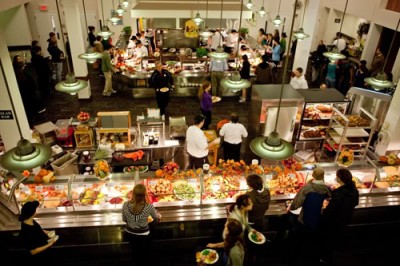Making healthy choices when it comes to food is probably not too high on the priority list for the majority of you college students. As far as to-do lists, it might fall somewhere in between washing that mug that’s been sitting on your desk since last week and organizing your sock drawer. And who can blame you, there’s an all you can eat buffet waiting for you for breakfast, lunch, and dinner. There’s late night dining serving up pizza and burgers. And of course when it comes time to cramming for midterms and finals what better way to stay awake than mindlessly munching on candy and Doritos washed down with a sugar laden energy drink? We’ve been there. We’re here to help you stave off the infamous Freshman Fifteen and hopefully spark some good eating habits that will benefit you long after you move out of the dorms. Here are our top ten tips to navigate the murky nutritional waters that is the college dining experience.
1) Go for the Green:
When faced with a multitude of tasty options in your dining hall, start at the stations with fresher choices. This includes the salad bar or any fresh veggie sides. Fill your plate to your heart’s content; remember to go light on the dressing (balsamic vinegar and olive oil make a great, more healthful alternative). Besides offering a good range of nutrients, the fiber in the veggies will help you feel full and can keep you from feeling the need to fill up on heavier options.
2) Portion Control:
When choosing other options in the dining hall, don’t feel like you need to completely ban certain food groups. Carbs, such as brown rice, whole grain pastas, and breads as well as healthy fats, like those found in avocados, walnuts, salmon, and peanut butter are important for a balanced diet. Just be aware of how much you’re putting on your plate. For the figure- conscious, a general portion size of rice or pasta is ½ cups. This is about the size of a hockey puck. For fats, depending on the type (olive oil, butter, nut butters) the general range for one serving is one to two teaspoons.
3) Say No to Social Eating
Food is a common thread in many outings, whether it’s for club events, after an intramural sports game, or just hanging out with friends. Pizza, late night fast food runs, and grocery store bought cookies and chips seem to be favorites. Basically, if you’re not hungry, don’t eat just because everyone around you is. If you know that you’ll be in this situation, eat something more substantial beforehand. Enjoy the company sans empty caloric intake.
4) Your Liver is Your Friend
We are not condemning alcohol. What would college be without it? A lot of studies have actually shown that moderate consumption of alcohol may lower your risk of developing osteoporosis, dementia, and even aid in weight loss. The key word ,however, is moderate consumption. Red wine is the most beneficial for the prevention of certain heart diseases and dementia. One glass a day is sufficient for women to reap the benefits. If your drink of choice is beer, go for lagers or wheat beers (examples: Heineken, Blue Moon, Shock Top), or light beers (all of which contain about half the calories and carbs of their original counterparts, ales, porters, and stouts).
5) Smart Snacking
When hunger strikes in between meals, reach for snacks that will help keep you full without weighing you down. Some good options are hummus and fresh veggie sticks, popcorn (not of the extra butter variety), apples or another favorite fruit with a tablespoon of peanut or almond butter, or a cup of lightly sweetened Greek yogurt topped with berries or some sliced bananas.
6) Have a Glass of Water
Keep hydrated throughout the day so you don’t confuse your body’s need for hydration with hunger. Keep a reusable water thermos with you while on campus and keep it filled. A good rule of thumb is to drink half your body weight in ounces of water.
7) Just Chew It
Sugar cravings are hard to shake. All you want is a red velvet cupcake or a rich, gooey brownie. Instead of giving in, chew a piece of sugar free gum. Yes, it’s ludicrous to think a piece of gum can completely satiate your overwhelming inclination to inhale anything chocolate, but it might just give you that burst of sweetness that will help you walk on by instead of tearing open that bag of M&Ms.
8) Late Night Dining
Don’t do it. Ideally, try not to eat two to three hours before you go to sleep.
9) Partner Up
Setting goals and sticking to them isn’t easy. Find a like-minded friend who wants to make his/ her health a priority and keep each other accountable.
10) Start Cooking
The best way to avoid unhealthy fast food and heat and eat meals is to get used to cooking. When you cook, you can control exactly what goes into your meals and snacks. When you don’t see all the hydrogenated oils, sodium, sugars, and preservatives going into store bought meals, you don’t think twice about them.














